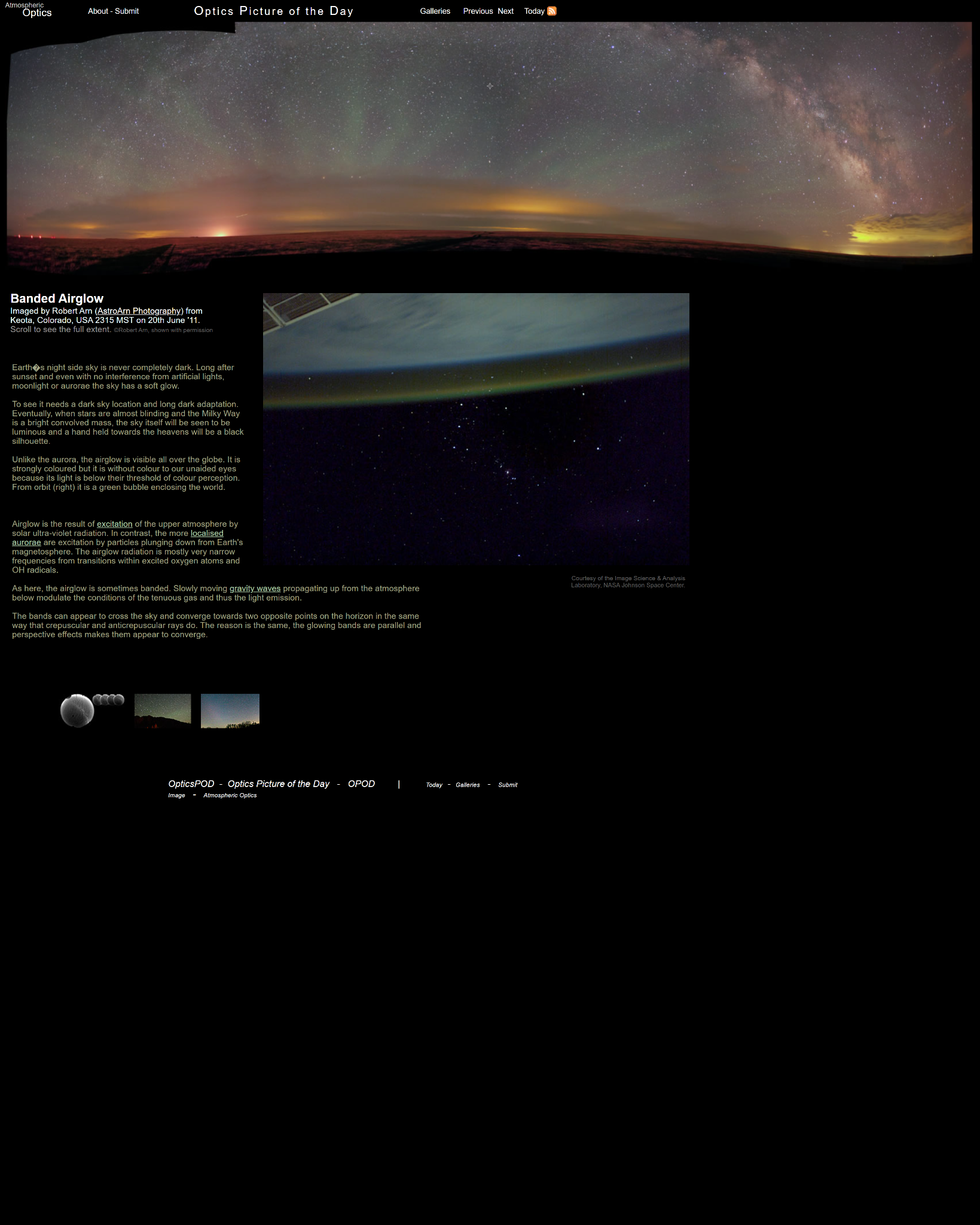OPOD - Banded Airglow
OPOD - Banded Airglow: Unveiling the Mysteries of Earth's Luminous Night Sky
Have you ever wondered why the night sky is never completely dark, even in the absence of artificial lights, moonlight, or aurorae? The answer lies in a phenomenon known as airglow. On Earth's night side, a soft glow permeates the sky, revealing its hidden luminosity. To witness this ethereal spectacle, one must venture to a dark sky location and allow their eyes to adapt to the darkness. As the stars twinkle and the Milky Way dazzles, the sky itself becomes luminous, casting an otherworldly glow. If you were to extend your hand towards the heavens, it would appear as a striking black silhouette against this radiant backdrop.
Unlike the localized nature of the aurora, which can only be seen in certain regions, airglow envelops the entire globe. Although it possesses vibrant colors, our unaided eyes perceive it as colorless due to its light falling below our threshold of color perception. However, when viewed from orbit, airglow manifests as a captivating green bubble encircling our planet, offering a mesmerizing spectacle to behold.
So, what exactly causes this fascinating phenomenon? Airglow is a result of the upper atmosphere being excited by solar ultraviolet radiation. As the sun's rays interact with the tenuous gases in the upper atmosphere, they induce a state of excitation within oxygen atoms and OH radicals. This excitation leads to the emission of light, predominantly in very narrow frequencies.
Interestingly, airglow can exhibit distinctive banding patterns. These bands are caused by slow-moving gravity waves that propagate upwards from the atmosphere below. As these waves modulate the conditions of the tenuous gas, they also modulate the emission of light. Consequently, we observe banded structures in the airglow.
The banded airglow can create a mesmerizing visual spectacle, with bands appearing to traverse the sky and converge towards two opposite points on the horizon. This phenomenon is reminiscent of crepuscular and anticrepuscular rays, where beams of sunlight appear to converge at the horizon. The reason for this convergence is the parallel nature of the glowing bands. Due to perspective effects, they appear to converge, adding a touch of enchantment to the already captivating airglow display.
While airglow has been observed and studied for many years, there is still much to learn about its intricacies. Scientists continue to explore the mechanisms behind its formation, the precise nature of the excitation processes, and the factors influencing the banded patterns. By unraveling these mysteries, we can gain deeper insights into Earth's atmospheric dynamics and better understand the interplay between solar radiation and our planet's upper atmosphere.
In conclusion, banded airglow offers a glimpse into the hidden beauty of Earth's night sky. Its ethereal glow, caused by the excitation of gases in the upper atmosphere, captivates observers worldwide. Whether viewed from a dark sky location or observed from space, airglow enchants us with its vibrant colors and mesmerizing banding patterns. As scientists delve deeper into the study of airglow, we inch closer to unraveling the secrets of this celestial phenomenon and gaining a more profound understanding of our planet's atmospheric dynamics. So, next time you find yourself beneath a starry sky, take a moment to appreciate the luminous wonder that is banded airglow.

Banded Airglow
Imaged by Robert Arn (AstroArn Photography) from Keota, Colorado, USA 2315 MST on 20th June '11. Scroll to see the full extent. ©Robert Arn, shown with permission

Courtesy of the Image Science & Analysis Laboratory, NASA Johnson Space Center.
Earth�s night side sky is never completely dark. Long after sunset and even with no interference from artificial lights, moonlight or aurorae the sky has a soft glow.
To see it needs a dark sky location and long dark adaptation. Eventually, when stars are almost blinding and the Milky Way is a bright convolved mass, the sky itself will be seen to be luminous and a hand held towards the heavens will be a black silhouette.
Unlike the aurora, the airglow is visible all over the globe. It is strongly coloured but it is without colour to our unaided eyes because its light is below their threshold of colour perception. From orbit (right) it is a green bubble enclosing the world.
Airglow is the result of excitation of the upper atmosphere by solar ultra-violet radiation. In contrast, the more localised aurorae are excitation by particles plunging down from Earth's magnetosphere. The airglow radiation is mostly very narrow frequencies from transitions within excited oxygen atoms and OH radicals.
As here, the airglow is sometimes banded. Slowly moving gravity waves propagating up from the atmosphere below modulate the conditions of the tenuous gas and thus the light emission.
The bands can appear to cross the sky and converge towards two opposite points on the horizon in the same way that crepuscular and anticrepuscular rays do. The reason is the same, the glowing bands are parallel and perspective effects makes them appear to converge.
Note: this article has been automatically converted from the old site and may not appear as intended. You can find the original article here.
Reference Atmospheric Optics
If you use any of the definitions, information, or data presented on Atmospheric Optics, please copy the link or reference below to properly credit us as the reference source. Thank you!
-
<a href="https://atoptics.co.uk/blog/opod-banded-airglow/">OPOD - Banded Airglow</a>
-
"OPOD - Banded Airglow". Atmospheric Optics. Accessed on December 23, 2024. https://atoptics.co.uk/blog/opod-banded-airglow/.
-
"OPOD - Banded Airglow". Atmospheric Optics, https://atoptics.co.uk/blog/opod-banded-airglow/. Accessed 23 December, 2024
-
OPOD - Banded Airglow. Atmospheric Optics. Retrieved from https://atoptics.co.uk/blog/opod-banded-airglow/.